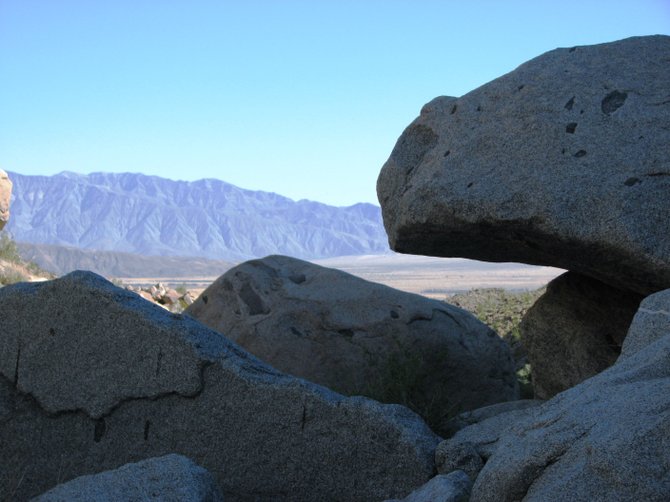 Facebook
Facebook
 X
X
 Instagram
Instagram
 TikTok
TikTok
 Youtube
Youtube

Pummeled by roaring, tent-folding winds most of the night, I awoke to the softest of morning gusts coming out of the canyon. Swaying in my hammock, I sipped freshly brewed licorice root tea surrounded by rabbits, lizards, quail and scores of hummingbirds attracted to the autumn blooms. It was my birthday and I was off to see Maidenhair Falls down Hellhole Canyon.
I passed people who had been sitting for hours in the early AM staring through binoculars, searching the crumbled mountainside for sight of the borrego. Of the 280 left in the country, about 200 of them reside in the park.
I figured if it was meant to be that I set eyes on one of the elusive Bighorn sheep that are known to frequent the park’s canyons, I’d see them as I trudged over, under and around the massive boulders strewn throughout the gap.
I thought the same thing about mountain lions or coyotes. Although mountain lions can be a hiking hazard, heatstroke and thirst are the number-one killers. Signs everywhere along the trails remind hikers that more deaths occur from lack of water than from lions.
Strapped with a gallon of water, I hiked on into the canyon in the wee hours before the sun was at its height. I’d come out to the desert to experience solitude as it was meant to be, and I wasn’t going to let thirst or wildlife prevent me from doing just that.
Besides the six developed campgrounds, some with $5 bike-in sites for cycling enthusiasts (not all of which are open, despite the park's website information, due to budget cuts), the Anza-Borrego has eight free primitive camping areas – one in a palm-lined oasis – stretched across its 600,000 acres and twelve wilderness areas.
Given the incredible winds I experienced tent-camping at Palm Canyon, I'll make sure to aim for one of the sandstone shelters next time; panoramic views are included in the $25-a-night fee.
Self-contained RVs and vans with higher clearance than my Celica made good use of the park’s off-road primitive camping policy, as visitors are allowed to camp for free anywhere in the park 100 feet away from a water source – which is almost everywhere, obviously, in a desert. Many a camper could be seen pulled off one of the 500 miles of roadway.
Although the summertime temperatures can exceed 120, the weather while I was there in early November was in the mid 70s, with a cool breeze, blue skies and not a cloud in sight. I thought I could easily spend the winter months here happily enjoying the solitude, scenery and perfect weather, as it appeared many others were doing.


Pummeled by roaring, tent-folding winds most of the night, I awoke to the softest of morning gusts coming out of the canyon. Swaying in my hammock, I sipped freshly brewed licorice root tea surrounded by rabbits, lizards, quail and scores of hummingbirds attracted to the autumn blooms. It was my birthday and I was off to see Maidenhair Falls down Hellhole Canyon.
I passed people who had been sitting for hours in the early AM staring through binoculars, searching the crumbled mountainside for sight of the borrego. Of the 280 left in the country, about 200 of them reside in the park.
I figured if it was meant to be that I set eyes on one of the elusive Bighorn sheep that are known to frequent the park’s canyons, I’d see them as I trudged over, under and around the massive boulders strewn throughout the gap.
I thought the same thing about mountain lions or coyotes. Although mountain lions can be a hiking hazard, heatstroke and thirst are the number-one killers. Signs everywhere along the trails remind hikers that more deaths occur from lack of water than from lions.
Strapped with a gallon of water, I hiked on into the canyon in the wee hours before the sun was at its height. I’d come out to the desert to experience solitude as it was meant to be, and I wasn’t going to let thirst or wildlife prevent me from doing just that.
Besides the six developed campgrounds, some with $5 bike-in sites for cycling enthusiasts (not all of which are open, despite the park's website information, due to budget cuts), the Anza-Borrego has eight free primitive camping areas – one in a palm-lined oasis – stretched across its 600,000 acres and twelve wilderness areas.
Given the incredible winds I experienced tent-camping at Palm Canyon, I'll make sure to aim for one of the sandstone shelters next time; panoramic views are included in the $25-a-night fee.
Self-contained RVs and vans with higher clearance than my Celica made good use of the park’s off-road primitive camping policy, as visitors are allowed to camp for free anywhere in the park 100 feet away from a water source – which is almost everywhere, obviously, in a desert. Many a camper could be seen pulled off one of the 500 miles of roadway.
Although the summertime temperatures can exceed 120, the weather while I was there in early November was in the mid 70s, with a cool breeze, blue skies and not a cloud in sight. I thought I could easily spend the winter months here happily enjoying the solitude, scenery and perfect weather, as it appeared many others were doing.
Comments